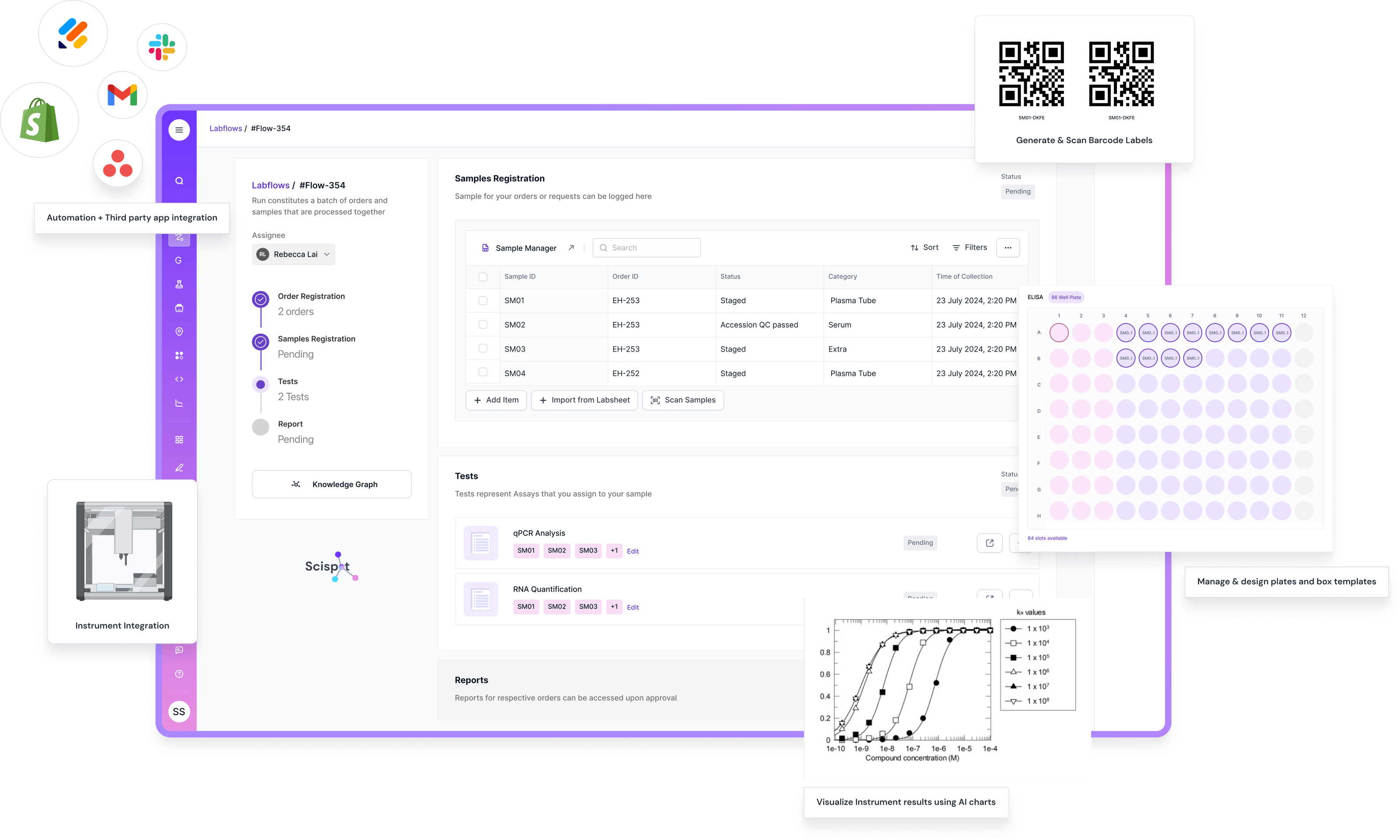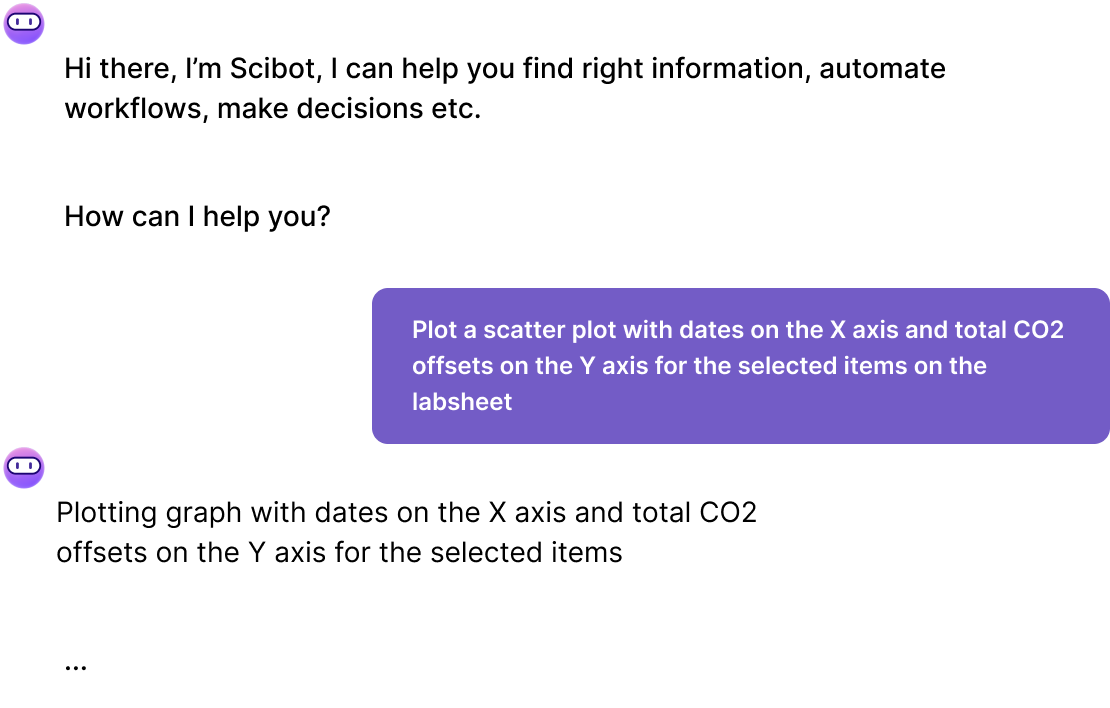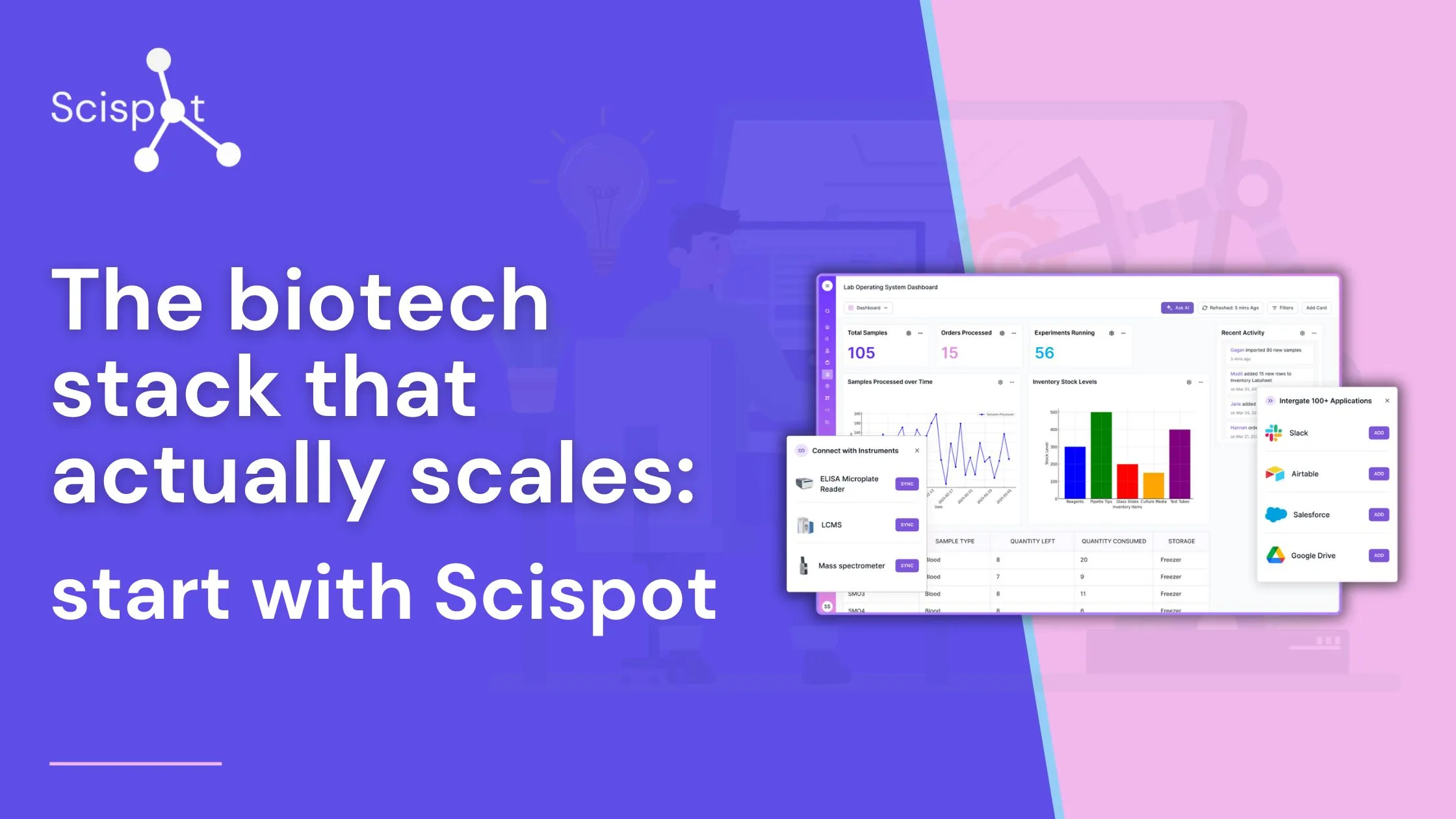You didn’t find a biotech to spend nights stitching spreadsheets to plate readers. You did it to discover, to heal, to build. Yet the first months feel messy. Experiments live in notebooks and email. Inventory hides in someone’s head. An investor asks about data integrity, and your heart drops. What you need is not a pile of apps. You need a lab operating system that transforms chaos into flow, making growth feel inevitable. That is why the smartest path is simple: anchor your stack on Scispot, then add a few focused tools as you grow. Scispot becomes the control room for your lab. Everything else plugs in.
Why Scispot first
Scispot positions LabOS as the backbone of R&D, enabling you to write experiments, trace samples, manage inventory, capture raw files, orchestrate approvals, and integrate instruments, analytics, and even finance, all within a single system. The value is not any single feature; it’s the unification. Your data lands in one model, in one place, from day one. You become audit‑ready and AI‑ready by design, not as an afterthought. Scispot even markets “100% data readiness for AI,” together with time‑to‑value claims like faster experiment design and lower IT cost. Treat the numbers as directional, but the intent is clear: build a reliable digital backbone early, and scaling gets easier.
The integrations are the kicker. Scispot advertises connectivity to hundreds of instruments and more than 7,000 cloud apps. That means your robot, your sequencer, your storage, your BI, and your purchasing can speak the same language without brittle one‑off scripts. When the team doubles, you won’t be hunting for glue code. You’ll be turning on connectors.
Scispot’s philosophy matches where the field is going: away from “automation islands,” toward self‑driving labs where devices and AI agents act on a shared source of truth. Think of LabOS as your lab’s digital nervous system. Sensors send signals. Software makes decisions. Robots move. Everything records itself. That is what makes scale graceful instead of painful.
There is practical stuff too. Inventory can decrement from the ELN and trigger re‑orders in systems like Quartzy or QuickBooks. It seems small until a critical reagent runs dry mid‑assay. Then it feels enormous.
On the plus side, you avoid tool sprawl, reduce migration risk, and get a clean path to compliance modules (alt‑QMS and alt‑LIS) when the time comes. On the trade‑off side, you adopt Scispot’s data model; legacy templates may need mapping. Niche cheminformatics can coexist with LabOS for a while. Since vendor performance figures are marketing-related, consider running a pilot to measure your lift. That balance is expected when you pick a platform.
A quick word about alternatives: Benchling is polished and popular, especially for molecular biology. It combines ELN and LIMS and has a large user base. If your team lives inside plasmid design all day, you may pair Benchling modules with LabOS concepts. But if your priority is to run the whole lab like a system and keep replatforming risk low, Scispot’s OS framing fits the scaling journey better.

What to add around Scispot, and when
Start with your data and operations in Scispot. Connect storage and chat. Map entities like samples, studies, and items. Hook the first instrument. Turn on inventory automation so procurement mirrors the bench. Once that spine works, add only the muscle you need.
For bioinformatics and visualization, teams without heavy coding can reach for Pluto to explore multi‑omics and build shareable figures. It reduces the distance from data to decisions and pairs well with a LabOS backbone. For immune repertoire work, MiXCR from MiLaboratories remains a reliable standard for TCR/BCR profiling. You get speed without reinventing pipelines.
As you widen your discovery engine, consider AI where it changes the odds. Companies like Insilico Medicine have pushed AI‑designed molecules into Phase II, a milestone that would have sounded like science fiction a few years ago. Exscientia helped lead the first wave of AI‑designed clinical candidates. Generate:Biomedicines is taking generative protein design into the clinic. Recursion has shown how image‑based phenomics, at industrial scale, can light up new biological space. You do not need to be them to learn from them. The lesson is simple: centralize your data and you give models something to learn from.
AI can also de‑risk trials before they start. Platforms like QuantHealth simulate outcomes with patient‑level digital twins, and public materials describe strong accuracy and recent strategic investment. Use these tools to kill weak programs earlier and concentrate capital.
In gene editing and synthetic biology, the toolbox keeps expanding. Mammoth Biosciences advances CRISPR systems through partnerships on both therapeutics and diagnostics. Prime Medicine pushes prime editing toward “search‑and‑replace” edits in human DNA. In ag‑bio, Hudson River Biotechnology applies CRISPR to crops with DNA‑free approaches. If you engineer cells, Asimov focuses on mammalian design and CAD. If you scale organisms for chemicals or materials, Ginkgo Bioworks offers a foundry model you can rent instead of build. Each of these pairs nicely with a LabOS core because your edits, measurements, and metadata land in one ledger.
Automation is where small teams punch above their weight. An Opentrons Flex or OT‑2 can remove the tedium from liquid handling without six‑figure CAPEX, and the APIs make integration straightforward. If you lack space or want to burst capacity, Emerald Cloud Lab or Strateos let you run methods on remote instruments and pipe the data back. The pattern is consistent: let robots and cloud labs lift the repetitive work while LabOS provides the provenance.
Not every startup needs diagnostics support, but when you do, the market shows what “new” looks like. Hera Biotech is pursuing a non‑surgical endometriosis test with positive interim data. Again, the point is less the category than the workflow: collect well, track cleanly, and your evidence stands taller.
There are services that compound your speed. Scientist.com gives you a governed marketplace to outsource assays and access CROs without endless vendor onboarding. If you are capital‑constrained, Capital Cell and Experiment have opened new ways for biotech to raise money from aligned communities. And for infrastructure, AWS offers patterns and guidance to run health and life sciences workloads with GxP and HIPAA considerations in mind. The benefit extends beyond compliance posture. It’s investor confidence.

A founder’s month with Scispot
Picture four quiet weeks that change your trajectory. In week one, you define the nouns of your science—samples, studies, requests—and import the templates your team already loves. You connect cloud storage and Slack, allowing the lab to communicate with itself. In week two, you wire your first instrument and switch on inventory automation, so using a reagent in an ELN entry updates stock and, if needed, raises a re‑order. In week three, you train the team on a simple assay that now runs end‑to‑end and logs itself. If you add a benchtop robot like an Opentrons Flex, you stream its output straight into LabOS. In week four, you set up a basic SDMS or lakehouse and enable approvals and audit trails, making your future GxP ramp a configuration rather than a replatform. Now you look at your lab, and it finally looks back.
What other tech actually helps
Three ideas move the needle more than shiny demos. First, automate anything repetitive—a day saved every week funds more science than a dozen pitch‑deck features. Second, outsource spikes in demand to cloud labs or vetted CROs to avoid inflating fixed costs. Third, capture data once in your lab OS and reuse it everywhere—analysis, purchasing, reporting, and board updates—so the past feeds the future. The specifics vary by company, but the pattern holds.

How blockchain can protect R&D data and IP
Use it where immutability and access control matter more than throughput. A permissioned ledger gives you a tamper‑evident audit trail for data, permissions, and even trial documents. Projects like PharmaLedger have shown traceability and clinical‑trial data sharing patterns that reduce ambiguity about “who saw what, when.” For health data sharing, the MedRec concept from MIT and applications like Genomes.io illustrate how users can retain control while granting auditable access. For IP, Molecule pioneered IP‑NFTs and programmable licensing so that early assets can raise funds and move between labs with clearer rights. The upside is integrity and transparency; the downside is privacy engineering, KYC, and the reality that large files still live off‑chain with hashed proofs on‑chain. Use it like a black‑box recorder, not a database.
Who’s using AI well in drug discovery?
There is real momentum. Insilico Medicine advanced a generative‑AI target and AI‑designed molecule into Phase II, earning the USAN name Rentosertib. Exscientia helped bring the first AI‑designed candidates into human studies and maintains a clinical pipeline. Generate: Biomedicines reports progress on generative protein therapies as it moves programs forward. Recursion proves that massive image‑based phenomics and foundation models can surface tractable biology at scale. You should be inspired, and you should be sober: recent reporting still notes no AI‑designed drug has reached the market yet. Build your stack so you can join the leaders when the moment hits.

The quiet confidence of being scale‑ready
When a regulator or partner asks about data lineage, you open a record and every step is there. When a robot or cloud lab finishes a run, results appear exactly where they belong. When your board wants to see cycle times, you build the chart from live data, not memory. That feeling—of a lab that runs like a system—is what wins time, trust, and the next term sheet. Start with Scispot to get that feeling sooner. Layer in bioinformatics, AI, CRISPR tools, and automation where they remove risk or add speed. Build a stack that can say “yes” to growth.
Key takeaways in one breath
Make Scispot the spine so your science, instruments, and people move as one. Add targeted tools only when they compound speed or quality. Use blockchain for auditability and programmable IP, not storage. Learn from AI leaders, but keep your expectations grounded. Do less integration theater and more integrated science.
.gif)





.webp)
.webp)
.webp)



